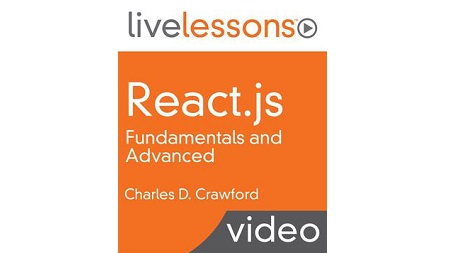
English | MP4 | AVC 1280×720 | AAC 44KHz 2ch | 8h 12m | 3.31 GB
ReactJS Fundamentals provides a conceptual understanding of React, an open-source JavaScript framework from Facebook, and gets you started with writing React code while utilizing advanced JavaScript and modern es6 features.
Advanced ReactJS looks at the libraries that make React a complete front-end solution for building applications. First, React router is covered, which is the de facto standard React routing solution. Next, the training looks at Flux, the original data management pattern for large React apps. Then, the training covers the fundamentals of Redux, an extremely popular data management library inspired by Flux. Finally, the video series discusses strategies and libraries that are useful for testing react applications.
What You Will Learn
- React toolchain
- Advanced JavaScript features used with React
- ES6 features with React
- Basic React concepts
- React’s virtual DOM
- Coding a React app with traditional and ES6
- React performance
- Utilizing libraries to make React a complete front-end solution
- React router
- Flux
- Redux
- Testing React applications
Table of Contents
1 React.js Fundamentals and Advanced LiveLessons – Introduction
2 1.0 Learning objectives
3 1.1 Understand the requirements of your toolchain
4 1.2 Use NPM to manage your application’s dependencies and run tasks
5 1.3 Compile es6 to es5 with Babel
6 1.4 Bundle applications with Webpack
7 1.5 Understand how Babel and Webpack work together and create a basic build process
8 1.6 Create a development optimized build process
9 1.7 Create a production optimized build process
10 2.0 Learning objectives
11 2.1 Use functional programming in JavaScript
12 2.2 Understand execution context and the this keyword!
13 2.3 Control execution context with bind_call_apply
14 3.0 Learning objectives
15 3.1 Understand ES6 template strings
16 3.2 Understand ES6 default arguments
17 3.3 Understand ES6 rest and spread
18 3.4 Understand ES6 arrow functions
19 3.5 Understand ES6 destructing
20 3.6 Understand ES6 modules
21 3.7 Understand ES6 classes
22 3.8 Understand ES6 promises, Part 1
23 3.9 Understand ES6 promises, Part 2
24 3.10 Understand ES6 promises, Part 3
25 3.11 Understand ES6 fetch
26 4.0 Learning objectives
27 4.1 Utilize component-based design
28 4.2 Use one-way data flow and rendering
29 5.0 Learning objectives
30 5.1 Understand the virtual DOM versus the actual DOM
31 5.2 Understand the diffing algorithm
32 6.0 Learning objectives
33 6.1 Use createClass and render
34 6.2 Understand JSX
35 6.3 Set initial app state
36 7.0 Learning objectives
37 7.1 Create with new ES6 class syntax
38 7.2 Understand properties and state
39 7.3 Adding new state to an app
40 7.4 State changes through child components
41 7.5 Use inputs with React
42 7.6 Functional stateless components
43 7.7 Utilize data fetching in React applications
44 7.8 Understand React component lifecycle methods
45 7.9 Utilize content of custom components
46 7.10 Understand higher order components
47 7.11 Utilize propTypes
48 7.12 Utilize ref to access child components
49 8.0 Learning objectives
50 8.1 Improve child rendering performance by setting keys
51 8.2 Implement performance optimizations with shouldComponentUpdate
52 Part I Summary
53 Part II Advanced React.js LiveLessons – Introduction
54 9.0 Learning objectives
55 9.1 Implement simple page routing with react-router
56 9.2 Create a navbar using the Link component
57 9.3 Understand how to use URL parameters and deep nesting
58 9.4 Utilize index routes, links, and active route styling
59 9.5 Use the browser history
60 10.0 Learning objectives
61 10.1 Understand why Flux exists
62 10.2 Grasp the Flux architecture
63 10.3 Design your Flux views
64 10.4 Define action constants
65 10.5 Use the dispatcher
66 10.6 Define action creators
67 10.7 Understand stores
68 11.0 Learning objectives
69 11.1 Understand how Redux differs from Flux
70 11.2 Define action creators
71 11.3 Understand pure functions
72 11.4 Understand simple reducers
73 11.5 Implement a simple store
74 11.6 Bind reducers to your store and compnents
75 11.7 Refactor to container and presentational components
76 11.8 Design larger state trees
77 11.9 Understand combine reducers
78 11.10 Use higher order containers with react-redux
79 12.0 Learning objectives
80 12.1 Unit test a Redux reducer
81 12.2 Unit test a Redux action creator
82 12.3 Unit test a presentational component with Enzyme
83 12.4 Test component lifecycle methods with full rendering
84 Part II Summary
85 React.js Fundamentals and Advanced LiveLessons – Summary
Resolve the captcha to access the links!